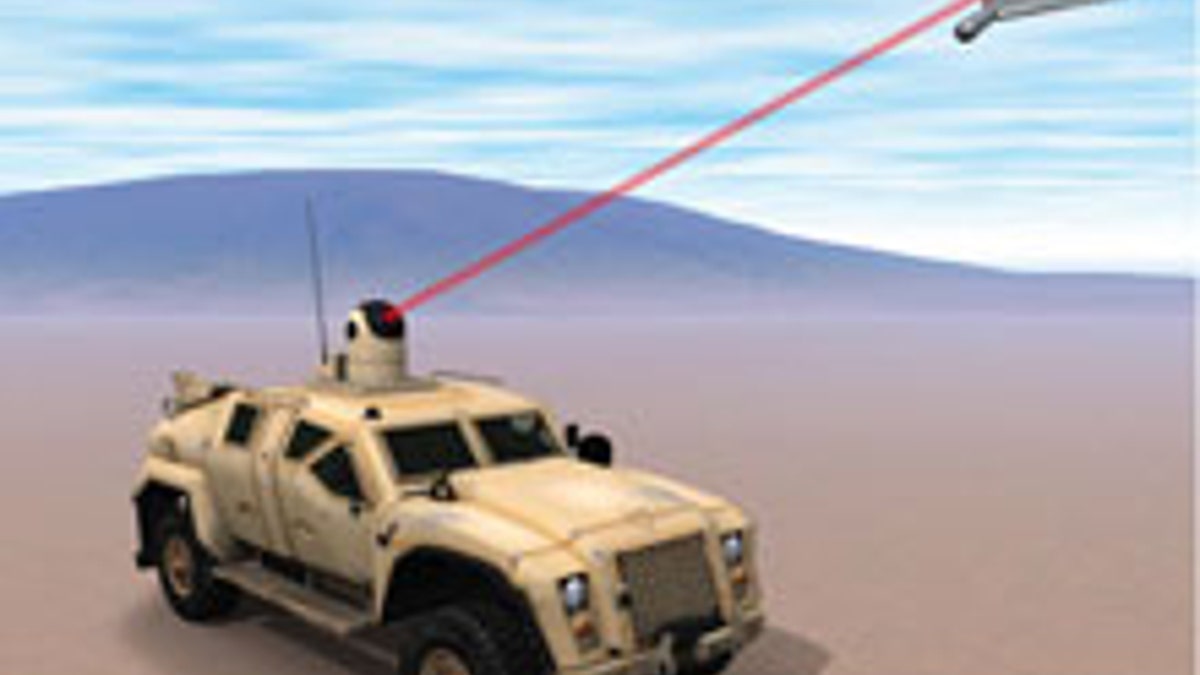
(Office of Naval Research)
The Office of Naval Research is testing a solid-state, vehicle-mounted laser weapon designed to incinerate a range of air and ground targets such as enemy drones, rockets and even IEDs, service officials told Military.com.
“Air defense covers rockets, artillery, mortars, UAVs, vehicles and IEDs – anything you can kill with a laser. This program is focused on going after the UAV threat. As we move into the future that broader threat set is fair game,” said Lee Mastroianni, program manager for the so-called Ground-Based Air Defense Directed Energy On-the-Move Program, or GBAD,
Using volumetric radar, command and control systems and a laser kill platform, the GBAD is a small, compact mobile weapons system designed to integrate onto a HMMWV or Joint Light Tactical Vehicle, said Mastroianni.
The GBAD is being prepared for a 10-kilowatt laser weapon demonstration in February of next year, Mastroianni explained.
Upcoming demonstrations are likely to be held at the Naval Surface Warfare Center, Dahlgren, Va., China Lake, Calif., or White Sands Missile Range, N.M.
“We’ve already done a demo detecting the passing of information to the laser kill platform and tracking and targeting,” he said. “In February we will be doing an end-to-end demonstration using surrogate technologies.
“As we move into 2016 and 2017, we’ll be working with our objective laser of 30-kilowatts and moving toward actual on-the-move targets. We will move around the battlespace to identify, track and mitigate the targets.”
The ONR research and development program for the GBAD is slated to finish up by 2017 in order to transition the effort to the Marine Corps. At this point, the plans are to then move the program into an Engineering Manufacturing and Development, or EMD, acquisition phase before heading toward formal production and delivery for operational use.
Engineering a small, mobile laser weapon of this kind presents a number of technical challenges such as how to sufficiently power and cool the system, Mastroianni added.
“We are operationalizing lasers that have been in development. The ruggedization, packaging, power and cooling – getting everything into an end-to-end system is where the big leap ahead is,” he said.
“Power and cooling are two of the larger challenges in order to get rid of all the excess heat. The laser itself is really small.”
The weapon is designed to provide maneuvering land units with high-tech, low-cost options to destroy targets such as nearby enemy UAVs. Mastroianni explained that solid-state laser technology converts electricity into photons or diodes which fill up the laser cavity, directing heat energy toward targets.
“This heats up targets. You get a tremendous amount of heat in one location that can cause a number of failures in the material and structure of a target – from burning to melting. This puts a lot of heat into a small area. From a cost-curve perspective this is a more efficient and effective way to go after targets,” he added.
The laser weapon would be lower-cost than using missiles or guns to attack threats such as an enemy UAS. Also, because the weapon relies purely upon electricity, it would be easier to transport than other kinds of ammunition.
The volumetric search radar provides the command and control system with a 360-degree area of coverage, allowing the fire control system to pinpoint targets for the weapon. The system is designed to ensure there is a “man-in-the-loop” to decide about when to fire on identified targets, he explained.
The ONR effort has called upon input from previous investments, studies and technology development initiatives including work by DoD’s High Energy Laser Joint Technology Office, MIT’s Lincoln Laboratory, Penn State Electro-Optics Center and the U.S. Army Space and Missile Defense Command.
Mastroianni said that the ONR is closely coordinating its developmental efforts with the Army’s laser program with a mind to how best to leverage the technology for the future.
“As technologies continue to evolve, we can put more power into the laser. This is the first major step toward operationalizing a system,” Mastroianni said.
“The Army has its High Energy Laser Mobile Demonstrator which is a high-powered, big system. We are dealing with a smaller compact system. Somewhere in the middle is where we will probably meet.”
ONR continues to work closely with industry on the development of the GBAD system, awarding contracts to as many as seven different vendors.
The contracts include a $10.7 million deal with Raytheon, $6 million deal with L-3, $400,000 deal with the Navitas Advanced Solutions Group, $1.1 million with Advanced Cooling Technologies, $2.2 million with Saze Technologies, $1 million with Equinox Corporation and a $1.1 million deal with Leidos.




















